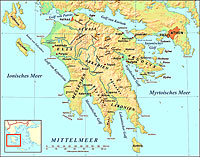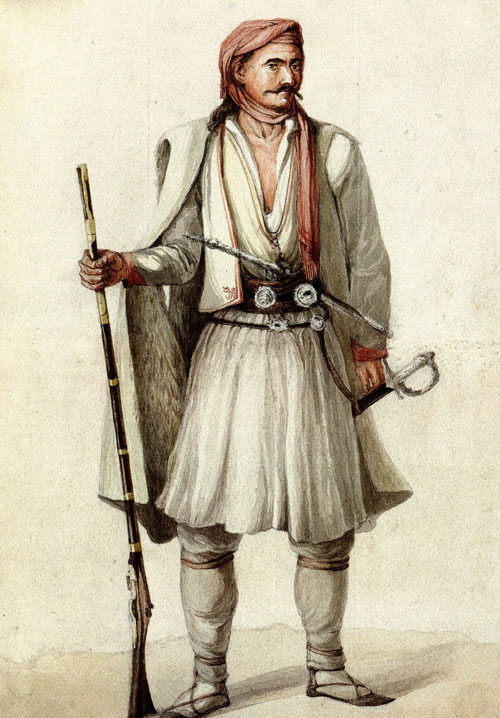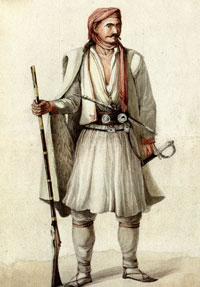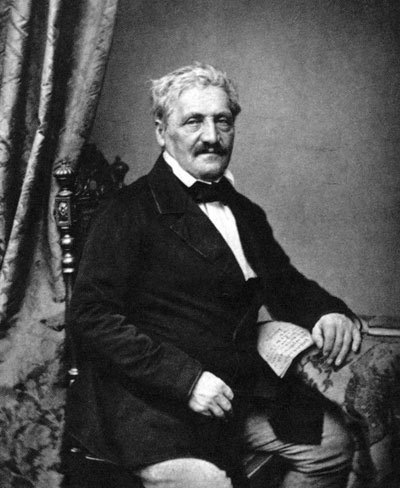| | Robert Elsie | AL Art | AL History | AL Language | AL Literature | AL Photography | Contact | |
Robert Elsie
Texts and Documents of Albanian History
BACK | AL History
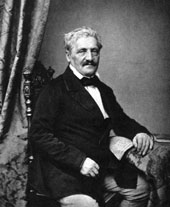
German historian Jakob Philipp Fallmerayer (1790-1861) in 1860.
1836
Jakob Philipp Fallmerayer:
The Early Albanian Settlement
of the PeloponneseJakob Philipp Fallmerayer (1790-1861) was a German-language scholar and historian from southern Tyrol, now in Italy. He grew to fame in Bavaria as a leading expert on the history of Greece in the Middle Ages, and in particular on the role of Slavic and Albanian immigration there. His two-volume treatise “Geschichte der Halbinsel Morea während des Mittelalters” (History of the Morea in the Middle Ages), Stuttgart 1830 & 1836, caused consternation and protest in philhellenic circles as he sought to show that Greece, and the Morea (Peleponnese) in particular, were not primarily populated by the descendents of the ancient Greeks, but by hellenized Slavs and Albanians, i.e. that there was no genetic continuity between ancient and modern Greece. In the first volume, provocatively subtitled “Untergang des peloponnesischen Hellenen und Wiederbevölkerung des leeren Bodens durch slavische Volksstämme” (The Fall of the Peloponnesian Greeks and the Repopulation of the Empty Land by Slavic Tribes), he stated: "The race of the Hellenes has been wiped out of Europe. Physical beauty, intellectual brilliance, innate harmony and simplicity, art, competition, city, village, the splendour of column and temple – indeed, even the name has disappeared from the surface of the Greek continent… for not even a drop of noble and undiluted Hellenic blood flows in the veins of the Christian population of present-day Greece.” The second volume of this work includes the following chapter on the mediaeval Albanian immigration to Greece and the Peleponnese.
Map of the Peleponnese (Morea)
The Albanians, who are nomadic by profession, were originally located in the mountains between Macedonia and Thessaly on the one hand, and in Epirus and the coast of Dyrrhachium [Durrës] on the other. Accordingly, the valleys and the lower mountain regions in Macedonia and Illyria were teeming with their herds and huts. Inconspicuous and unmentioned in the annals of history, they shared the fate of the other tribes in those reaches, that of paying tribute initially to the kings of Illyria and then, after their defeat by Philip and Alexander, of paying tribute to the Macedonians. Subjected to the Romans by Aemilius Paulus, they remained as anonymous shepherds in their wooded valleys while Rome conquered the world and lost it again. The division of Rome into a Western and an Eastern Empire did nothing to change their lives. For as long as Constantinople held onto power, however little, in the long centuries stretching between Theodosius and Andronicus II, nothing was known of this people, except that their herds drank from the springs of the Pindus mountains and that their tall and well-built men, in the bondage of traditional savagery, wandered about in their native mountains without caring particularly about what was going on in the outside world.
Everyone knows the country of Albania and the Albanians as a people living on the southern slopes of the Caucasus between the Caspian Sea and the Kur River from the descriptions left to us by Ptolomy, Strabo and Pliny, etc. It is curious to note that the Albanians in Illyria have noticeable similarities to these inhabitants of the Orient in their customs, physical appearance and names. Strabo’s assertion can apply to both: κάλλει και μεγέθει διαφέροντες (tall and well-built). The Albanians in the Orient inhabited mountains and flatland near the mountains. They disliked farming and preferred herding, hunting and taking booty. They had few towns and the ones they had were small. They preferred to live in scattered villages and settlements. In war, they were feared and more skilled on foot than on horseback.
Are such characteristics not found to a good extent in the Albanians of the Byzantine Empire, too? Does the name which the outside world has given to them not show clearly enough that they are a mountain people? Alban is an ancient word for peoples from Iran and refers to a mountainous region. In the language of the Orient, the Albanians were no other than mountain peoples, which meant strong and sprightly by nature. This is the root of the words alb, alps, alpes that have been and are still being used to describe various mountainous regions in Europe. In the mountains in Switzerland and Austria, whose inhabitants are primarily herders, the word alb is used to refer to the summer pastures in the high mountains.
The best proof that the word Albania originally meant ‘mountain country’ is the fact that, after the disappearance of the Pahlevi language and national freedom in Iran, Arab and European geographers often referred to the country in the Caucasus that was formerly called Albania as Daghestan (داخسان ) in their books, i.e. mountain land.
It is thus no surprise that, in addition to Caucasian and Macedonian Albania, we find regions, towns and rivers of this name in the Carnic Alps, in the Apennines of central Italy, on both sides of the Pyrenees and even in the highlands of Scotland, which was called Albania in antiquity. For this reason, we do not concur with the opinion of the noted Mr Saint Martin who derived the word ‘Albanian’ from aghuang, the Armenian word for this people which means ‘gentle habits.’ Gentleness is by no means a prime characteristic of the Albanians in their mountains.
We have no opinion on the assertion of Zonaras that, in the great migrations, the ancient Albanians were the same as the Alani who were driven from the Caucasus to Europe by the Tatars in the thirteenth century. Klaproth did, however, show that these Alani also lived in the mountains of ancient Albania.
It would seem the case that the Albanians did not give themselves this name. It was given to them by neighbouring peoples. In Greece they call themselves shkypitar and call their language shkypi. There does not seem to be any proof that there was ever a town call Skypiche in Caucasian Albania, as some geographers have suggested. Be this as it may, we do not wish to suggest here with the examples given above that the Albanians of Illyria stem from those in the Caucasus. We all know how uncertain such assertions of origin can be when they are based on one or more random similarities in the physical appearance, language or customs of two peoples, in particular when the migration or settlement of part of the people in question preceded all the historical reports and legends about them. The first historical information on the unfertile homeland of the European Albanians shows this people to be located in the same places they are today. They are but a small part of that great Illyrian tribe that once occupied all the land to the north and west of Hellas, including Macedonia and part of Thessaly. These people later assimilated everywhere to Greek customs and went under in the cataclysmic events that took place during and after the rule of Rome until very few of them were left in their high mountains. Their language, that bears traces of all the peoples that have invaded the region and ruled over it, has, in essence, not the slightest similarity to Greek or Latin. The warriors of Pyrrhus, Teuta and Gentius spoke the tongue that is now used by Miaoulis and Contouriotis and the inhabitants of Boeotia, Hydra, Attica and a good part of the Morea [Peloponnese] today. It is closer to the dialect of the people we now call the Vlachs, that are simply the remainder of an ancient people who, before the destructive expansion of Greece and Rome and the devastating migrations and invasions of the Scythes and Celts, inhabited the territory of Thessaly and the interior mountains of the Illyrian triangle. Savagery and harshness seem always to have defined the character and the customs of these two peoples, as has a lack of interest in beauty and culture. Whether these deficiencies are innate to the Albanian people and can therefore not be changed will be seen in the coming decades since many of them are now under a Christian government, one that is well-educated and is devoted to culture, and are living on the part of Greek territory that once produced the most creative stimuli ever known in intellectual life and the arts.
A southern Albanian warrior
sketched by Joseph Cartwright
in 1822.
The capital of this people and seat of the ruler of Greek Albania was called Albanopolis, i.e. ‘Albania town,’ by the Byzantines. What the Albanian shepherds called it, we do not know.With the destruction of the Greek Empire in 1204, the mountainous region of Albania came under the sway of Despots Michael and Theodore Angelus of Joánnina, Epirus or Acarnania. They used all of these titles. Under their successor Michael, the Albanians of Kastoria under their leader Gulamos came under the rule of Joannes Vatatzes, Emperor of Nicaea. The mountain fortress of Croja [Kruja] and the other settlements of this people to the west of the mountains also fell to Nicaea. In 1255, as soon as Joannes Vatatzes died and was replaced by Theodore, they went back to the Despot Michael Angelus and drove the Nicaean governor from their land. Under the Emperor Michael Palaeologus and his son Andronicus, against whom the princes of Joánnina had difficulty maintaining their freedom, the Albanians returned to imperial authority. Nonetheless, when a long period of unrest between Andronicus and his nephew made the weakness of the Byzantine Empire more than obvious, the Albanian nomads refused to serve a nation that was unable to defend itself or anyone else.
The Albanians had earlier raided and pillaged the neighbouring towns of the Vlachs from time to time and had even chased an army division from the field and caused losses in the great campaign near Joánnina. However, when they had attained their goals, they returned to their mountain homeland.
In 1333 one begins to notice an endeavour among this fickle people, now desirous of change, to rise and create a nation of their own and to settle permanently in regions that they had only penetrated occasionally for raiding and pillaging. Suddenly they rose from their mountains and attacked the fortresses and towns of the Greeks on their territory. Beligrad [Berat], Canina [Kanina], Screpári [Skrapar], Clissúra [Këlcyra] and Timóri [Tomorr] were already in their power or surrounded when Andronicus the Younger, Emperor of Constantinople, appeared with an army consisting of an infantry of lightly armed Turkish archers to pursue the rebels into the nooks and crannies of their lofty mountains, into which they were wont to withdraw whenever they were faced by orderly armies.
These warriors, subsequently so feared, were easy prey for the Turkish archers. Partly for lack of weapons and partly for lack of experience, they were unable to defend themselves in their native mountains from the assault of these fearless Anatolian Velites. Many of the Albanians were killed, and many more with their women and children were enslaved and carried off by the Turks. It is said that 5000 horses, 300,000 head of cattle and over 12,000,000 sheep were seized. They were distributed in the mountains and among the inhabitants of the pillaged towns. Others were indeed sold at a modest price back to the conquered Albanians, whom the gentle Andronicus had pardoned.
Joannes Cantacuzene also found ways of putting down a second revolt of this people in the mountains of Thessaly after the death of the Emperor Andronicus.
Although they had been put down twice, they continued their migrations into the plains of Thessaly and the rich pastureland of Acarnania unimpeded and, no longer satisfied with plunder, they created new settlements in the guise of peaceful subjects. They became aware that the time had come to leave their mountain homeland and supplement and strengthen the scarce population of new Greece. After the outbreak of the often mentioned civil war between the Cantacuzene and Palaeologus dynasties in Constantinople, there was nothing to stop them in their progress. They rose a third time, suddenly and everywhere at the same time.
Nicephorus Angelus, the last scion of the Despot of Arta or Joánnina had fled from his home in Thrace during the general confusion that reigned in Constantinople, and retook the paternal inheritance that was his in Epirus. In 1347, this prince endeavoured to subject the nomads of Albania who had now reached the Aspropotamus (Achelous) river in Acarnania. However, despite all this Turkish auxiliaries, he was struck in the head at the village of Achelous and his whole army was destroyed.
From this day onward, the Albanians constituted an independent nation in Greece. The whole region between the Drin river and the mountains of Chimaera [Himara] was now called Albania proper. Later on, Epirus, Aetolia and part of Thessaly and Macedonia were also to be called Albania or Arnautland in a broader sense of the word. Guini de Spata, one of their most famous leaders at that time, conquered the whole province of Old Epirus, or the Despotate with its two capitals Arta and Joánnina, and, in league with the Slavic prince, advanced from Salona to Angelokastro in Aetolia. At the same time, Balza [Balsha], another commander to the north in Durazzo [Durrës], Canina, Beligrad and Kastoria, took possession of Upper Macedonia.
Although outside their traditional mountain homeland they were not able to maintain rule in the towns and plains beyond the end of the fourteenth century, great numbers of them remained in the said regions as nomads or farming colonies. To the north, the great Serb king Stephen subjected a number of their regions and gave them to the Greek Emperor Cantacuzene as a dowry for his daughter.
After his death, under Balza, they not only took back from his many weak successors everything they had lost, but also subjected large swathes of territory between the Drin river and the bay of Cattaro [Kotor], with the important towns of Scutari [Shkodra], Dulcigno [Ulqin/Ulcinj], Antivari [Bar] and Trebigne [Trebinje]. They were the scourge of the Serbs, Bosnians and Bulgarians until the year 1383 in which Sultan Murad I soundly defeated them near Beligrad on their own territory. He slew the bravest of their chiefs, and Carl Tocco, the new palatine of Zante and Cephalonia took back from them rule over Acarnania and Old Epirus.
Nonetheless, Albania remained, from that time on, an armoury from which the princes of Greece derived not only their military might but also population and farmers to resettle all the villages and countryside that had been depopulated by war and starvation.
The Albanians seemed to lack nothing to become a great people and to rise as conquerors, as their neighbours, the Macedonians, had once done, except a leader, a man in their midst who could muster all the warriors among them, gather them together and subject the chieftains to the will of one individual. If the great and powerful commanders who rose, one after the other at this time under the Ottomans, had worked for the Albanians, they would have kept rule in those reaches. However, the spirit of the times dictated that the Albanians would be long-term tools in the hands of the Ottomans who, with their help, would wrench Greek civilisation, still amazing in its dilapidated state, out of its very foundations.
At least one hundred years passed after the death of Scanderbeg (1467) until they were fully subjected to the Turks and gradually converted to Islam. In this long period they spread throughout the provinces of interior Greece and constituted a barrier, the only population to resist the inflow of Turkish subjugation and barbarity.
The first Greek prince we know for certain to have introduced Albanian mercenaries and colonists to the far reaches of the country was Manuel Cantacuzene, the Despot of Mistra. We noted in the previous chapter that, with the help of a troop of Albanians, he subjected his rebel leaders, that his personal bodyguards consisted of Albanians and that the rule of fortresses from Monemvasia to Mistra was also conferred upon warrior of this nation.
Manuel’s father also noted that his nation was particularly faithful to his dynasty and long endeavoured to avenge the wrongs done to him by his foes. This faithfulness can easily be explained from the situation at that time. As the underdogs, the party of Cantacuzene was forced to buy protection from these nomadic warriors with extensive grants, land, gifts and privileges, far beyond what a legitimate ruler would wish to have accorded.
Manuel gave the Albanians land in the region of Veligosti and in the valley of Rufia, from Nikli downstream to Karitena and the canton of Skorta and did so with a double purpose: firstly to promote agriculture and secondly to have the Albanians serve as border militia against the Franks in Achaea. In 1391 we find well-settled colonies of such Albanians around Londari and Tabia in the canton of Skorta that were able to muster a powerful army. The question as to how and when the Albanians settled in the centre of the Morean Peninsula has thus been solved. They cannot have arrived before the Cantacuzene civil war because their migration from the Pindus mountains and the upper reaches of the Drin river did not begin and cannot have begun before this time because the Despots of Arta and the great campaign would have block their way into the Morea.
However, by the time they vanquished the Catalonians at Gardichi near Joánnina around 1330 and had overcome and slain the Despot of Arta on the banks of the Aspropotamos in 1347, they had advanced with their troops and tents right to the edge of the Morea and accompanied the young Manuel Cantacuzene to Mistra in 1349. The perilous situation faced by the new ruler among his faithless chieftains and his cowardly and treacherous subjects soon forced him to let great masses of these foreigners into the region to protect him and his land. The accuracy of this assumption is proven by an incontestable passage in Theodor Spandugino. According to this author, Manuel’s father, the Emperor John Cantacuzene, invited the most influential and rebellious part of the population from the region of Albania given to him by Serbian King Stephen to the Morea so as to put down frequent rebellions against his rule. Further information from the aforementioned Spandugino shows that the migration involved not simply a few aristocrats or a small number of families. He attributes the decline of northern Albania and its final collapse to this forced resettlement undertaken by Cantacuzene. The towns of Tabia and Londari are mentioned for the first time in this connection. The latter is situated near the one-time settlement of Veligosti. The former was established by the Albanian immigrants on the other side of the Tripolitza mountains, on the upper course of the Barbutzena.
If the many colonies of Albanian immigrants had already exchanged their native tongue for modern Greek, as their predecessors, the Slavs, had done, and as could have happened over the centuries, the opponents of my theory of Albanian migration covering all of new Greece would have had an easier time of it refusing to believe me, because the new arrivals, comrades in religion and governance of the Greek-speakers, did not have the same destructive influence on place names, as did the Slavs. Phrantzes asserts: “Half of Peloponnese land was actually occupied by the Albanians at that time and they attempted to get the other half, too, both by force of arms and by negotiation with Sultan Mehmed II.” In the works of Chalkokondylas, Spandugino and Phrantzes, or similarly concerning the Slavic occupation of the Peloponnese in Evagrius, Constantine Porphyrogenetus, the Scholiast of Strabo and Patriarch Nicholas, the above-mentioned scholars would only come up with the same old explanations, i.e. that “these are merely assertions of a general nature that must be treated with caution when applied; they are assertions that reflect more a lack of knowledge or imprecision on the part of the writer than truth and exactitude.” Unfortunately for the friends of ancient Greek cause, gentle folk they may be, though not particularly astute, the inhabitants of the Academy of Plato and of all of Attica, of Boeotia, Megara, Corinth, Argolis, Hydra, Spetzia, Phlius and the interior of the Morea, have preserved the customs, language and clothing of their native land to the present day. However, if we take a look solely at the Peloponnese, no one would accept that the martial advance of the Albanians through the peninsula at the time of Cantacuzene simply came to a stop and consisted merely of a few small units of men or a few mercenaries who left their families at home. Once curious piece of information is preserved in the funeral oration of Theodor Palaeologus, the successor of Cantacuzene in Mistra (1380-1407), that shows just how continuously and massively the Albanians flooded across the isthmus: “Ten thousand Illyrians, i.e. Albanians, were given residence in the Peloponnese by Theodor Palaeologus, and these ten thousand men brought their women and children, their possessions and animals with them.”
If one considers that all the families of Albanians who arrived in the Morea during the rule of Manuel Cantacuzene and Theodor Palaeologus, in the province of Mistra. i.e. in the Eurotas valley, had to be accommodated in southeastern Arcadia, Tsakonia and the towards Argolis, it is easy to see that the districts inhabited by Slavs and, on the east side, apparently by some remnants of the ancient Greeks, were largely empty. And if one considers that before and during these events there was a time when there were less than 150,000 people in the whole of the Peloponnese, one can easily comprehend how limited the knowledge of the philosopher Plethon in the fifteenth century was, who refused to accept any substantial alteration in the population of the Peloponnese. The same is can be said of his successors in the present day, at least in this part of the world.
The temperament of the immigrants was evident in their new homeland, too. They were submissive for as long as they were weak, but rose after the death of their benefactor Manuel, whose liberality had allowed their numbers to increase as we have noted and will explain in greater detail below.
Under the Frankish princes of the Morea, Rainerio Acciajoli followed the example set by Manuel Cantacuzene.
Nerio, as he was called for short, as noted above, purchased and gained the fortress and region of Vostitsa from Princess Maria Bourbon. A few years later, he inherited the Castellania of Corinth from Peter of San Superano, Maria’s governor and viceroy in Glarentza, with the right to award or sell it, or otherwise partially or wholly dispose of it, though while paying homage to the Prince of Achaea. A large part of ancient Achaea, the region of the one-time republics of Pallene and Phlius, all the land around the isthmus and the one-time region of Argolis right to the districts of Epidaurus and Troezen across from the island of Hydra were subject to the new Castellan of Corinth. Few regions of the Morea had been as completely devastated as the abovementioned ones. These were the preferred playgrounds of the Turkish hoards and the Catalonians of Athens, who had landed here. Villages without a single inhabitant, such as Poscarinion, and regions devoid of any agricultural activity, could be encountered frequently here. Outside the fortresses and the areas immediately surrounding them, there was no security to be had for persons and property. No year passed without Turkish or Frankish adventurers landing the Gulf of Corinth and devastating one part or another of the much divided and as such undefended peninsula.
Count Louis Beaumont, the son of King Philip IV of Navarre, married the hereditary duchess Joanna of Durazzo and sent a troop of 600 soldiers mustered in Gascony from Italy to Durazzo. More substantial numbers of fighters were to follow, with whose help he intended to conquer the surrounding regions of the Albanians and Slavs. He died in Apulia in 1373 before the ambitious undertaking could begin, but his Gascon soldiers in Durazzo attacked the chieftains of northern Albania of their own accord and soon presented quite a threat. The Albanian leader Balza (Balsh), who laid siege to them in Durazzo, was defeated and only succeeded in expelling them from the region by paying them off with 6000 gold ducats. They embarked and set sail for new adventures in southern Greece. They landed in Vostitsa in the Morea, conquered the fortress and advanced to Corinth and the lands of the Parea. The situation was chaotic but this troop of 600 resolved thugs was able to change ownership of almost all of that part of Greece. If we are to believe Chalkokondylas of Athens, they even conquered the towns of Athens and Levadia, taking them from the Catalonians, and were only driven out of the duchy in 1382 by Viscount de Roquebertin using Albanian and Sicilian forces.
No one would have learned of this turbulence in history had not Nerio of Corinth and the Parea of Athens invited Albanian military colonies to settle in Attica, Argolis, the Castellania of Corinth and the mountain valleys along the Gulf of Corinth. There are historical documents showing that the Albanians assisted the Castellan of Corinth and the ruler of Athens in that war, but not that their settlements were established there in the intermediate years of 1373 to 1382. Even though the settlements here go unmentioned in the documents of the period, they are a fact, just as this is true, somewhat earlier, for the Byzantine part of the Morea. A few decades later, we see that the regions in question were swarming with colonies of this people and defended solely by Albanian weapons against the advance of the Turkish army under Bajazid and Murad I.
Nerio had empty villages, fallow fields, many enemies and no soldiers. The Albanians were on the lookout for land, war and booty. Anyone who is sufficiently informed about the Morea, the diversity of its population, its customs and habits, its language and houses, will known that the inhabitants of the onetime states of Corinth, Argos, Epidaurus, Hermione, Sicyon and all of the mountain region of Phlius right to Patras are still primarily inhabited by Albanians, who, in some few regions have exchanged their mother tongue for modern Greek and in the repeatedly ravaged cities of Corinth and Argos have mixed with the Greek-speaking inhabitants.
Several years later, the adventuresome Castellan of Corinth gained control over most of the lands of the Parea that were plunged into war and subject to Sicilian influence, and spread Albanian colonies to Attica and Boeotia where this people still resides pure and unmixed with others. With the exception of some villages in Boeotia and the cities of Thebes and Athens where the population during the last uprising was a mixture of people from all regions, Albanian blood is dominant and is most prevalent in the lower classes. At the present time, Athens, the capital of the new kingdom, is more Albanian than it was during the uprising because, after the expulsion of the much-hated and feared Ottomans, the Albanian population abandoned the countryside in great numbers and settled in the city. There, a special court had to be set up in Albanian to administer justice to the non-Greek-speaking citizens of Athens.
[Extract (excluding footnotes) from Jacob Philipp Fallmerayer, Geschichte der Halbinsel Morea während des Mittelalters, volume 2 (Stuttgart 1836), pp. 240-263. Translated from the German by Robert Elsie.]
TOP

